Author
Let us look at some classics today. And with a very good price, too... I have refrained from giving a suggestion because the price at Amazon was at 900 USD (!!!), but I am happy to mention one of the greatest books on declarer play for only 2 bucks.
0 Comments
AuthorI recently hit upon a very clean, crystal clear example of how counting in defense can direct you to an unintuitive play.
AuthorIt is very easy to see intermediate or even advanced players getting confused about the proper signalling method when you are breaking a new suit in defense.
AuthorIt is quite common to see partnerships composed of players at an intermediate, or even at a beginner, level using very complex bidding conventions.
AuthorMany times at the Bridge table, a player can commit a very costly error: trying to guess his opponents' cards based on his own beliefs and judgment about what is correct.
AuthorSometimes, a defender can paint a misleading picture for declarer, giving him the wrong impression of the hand by discarding – or not discarding – a suit.
AuthorIn any given bridge hand, the likelihood that the opening lead will be the most important card played is very high. More contracts are won (or lost) on the opening lead than on any other card. You will never be able to reach your highest bridge aspirations if you do not devote some study to the improvement of your opening leads. While defense is said to be the hardest part of bridge, the opening lead is the hardest part of the defense. But this does not mean that the opening lead is a matter of chance. Quite the opposite: the expert makes the "killing lead" more often than the average player. There are some principles that help the expert when they are picking the opening lead, which can be employed profitably by all players. Above all, we must pay attention to the auction before leading. Perhaps the biggest difference between the expert and the average player in this department is that the expert chooses his lead taking the bidding into account, while the average player looks for the "table of opening leads" (AK, KQ, singletons, etc.) and picks his lead according to that table. There is nothing wrong with that -- the expert, other things being equal, also follows this routine. The problem is that the other things are very seldom equal! Let us examine a simple example of this idea: After this bidding, if you gave this hand to a panel of experts, the heart lead would be close to unanimous. The bidding did not give us any clue to pick between spades and hearts, and the heart suit is safer (thanks to that 9). If the opponents have A10x in the dummy and Kxx in hand, both leads are bad, giving up a trick that declarer would not make by himself; but if these cards are inverted, the 9 of Hearts is still guarding your Jack. A slight modification already produces a startling effect: With the same auction, you would probably see some controversy in this second hand. Some experts would lead diamonds (the best suit), for the same reasons presented above, but many others would lead hearts. Why? Because the red suits are not equivalent in this auction, unlike the major suits of the previous example. If dummy had 5 hearts, he would almost always bid the suit (by a transfer). If there were 4 hearts there, he would often have explored the possibility of a 4-4 fit (through the use of Stayman). In other words, the 1NT-3NT auction, in most cases, denies 4+ cards in a major (in dummy). And these inferences are not applicable to the diamond suit -- dummy can have 4, 5, or even 6 cards there. We see here how the inferences from the bidding -- including not only the bids that were made, but also the bids that were not made -- can influence the choice of opening lead. If the red suits were identical (either with or without the 9), you would see a very clear majority of experts leading hearts, for objective reasons. In our actual example, with diamonds a bit stronger, the opening lead is not so clearcut. (It is worth pointing out that top partnerships are aware, and have been for many years, of this inferences from the bidding when they are responding to 1NT, and thus avoid Stayman, or even using a transfer, in hands that "look a lot like NT". The more "automatic" is the investigation of a possible major suit fit from dummy in the opponents' partnership, the more indicated is the major suit lead against an auction such as 1NT-3NT). Let us take a look at how this can impact the decision of great players in a real hand. In 1979, the Reisinger ended in a tie, and there was a tie-breaker round of 12 boards between the two leading teams. On the 5th hand of this tie-breaker, the East players had to lead against 3NT from:  What is your lead? You already know that the question is incomplete. You have to ask what was the bidding! At one table, the auction went like this: 1NT by RHO, you passed, 2 Diamonds (Forcing Stayman, not a transfer) from LHO, pass from partner, 2NT from RHO, denying a 4-card major suit (are you thinking about your lead?), you passed, 3NT from dummy, all passed. And now, what is your lead? Dummy showed some interest in the major suits (else he would have just bid 3NT directly). Declarer doesn't have a major suit of 4+cards. Dummy had the entire 3-level to investigate a possible problem in 3NT, but decided against it. So, dummy is not really concerned about opener having a low doubleton, or three small cards, in a major. Taking all of these clues in, Bobby Levin led from his strongest suit, a low club. Let us go to the other room now. The auction there went like this: 1NT from RHO, you passed, 2 Hearts (transfer) from LHO, partner passed, 2 Spades from RHO, you passed, 3NT from LHO, all passed. Ira Rubin had these cards. From his viewpoint, dummy probably did not have 4 hearts (he would have preferred Stayman with 54 in the majors). Declarer may have 4 hearts, but he may also have 4 diamonds, or 4 clubs, and it is rather more likely that he will have 5 (or more!) clubs or diamonds, than hearts. In other words, by the pure "count of cards in each suit", it is more likely that hearts are the combined longest suit for the defense. And so he led a small heart. This was the full hand: Note how both leaders were correct in the inferences available in each auction. Nevertheless, one of them hit on the killing heart lead, while the other lost a trick in the opening lead. As usual, the opening lead was the most important card. Let us now end this article with the analysis of a brilliant lead, from Gabriel Chagas, which decided a South American championship against Venezuela, some 40 years ago. Chagas had something like the following hand, and this was the auction: 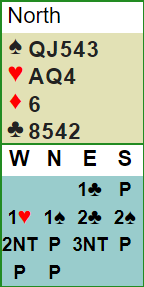 Chagas reasoned as follows: Declarer clearly has a spade stopper, or two. Dummy is hoping to make the contract by running clubs. And North's club holding is ominous for the defense. The odds that the clubs will run (or perhaps that partner has a stiff honor which will be soon revealed -- something like KJ10xxx and Ax with the opponents) must be huge. This means that, for the spade lead to be the best, partner must have a spade honor and a club stopper; if he does not have that club stopper, declarer will probably be able to run 9 tricks before the defense can do anything else, even if the spade suit is established in the opening lead. The entry in hearts will be too late to break the contract. On the other hand, the opponents did not try to find a heart fit. Support doubles were not in vogue back then, so dummy would probably make an effort to reveal 3 cards in hearts, whether by supporting directly at his second bid, or, almost certainly, by bidding 3 Hearts over 2NT. That means that the hearts are most likely 4-2 (or perhaps even 4-1) with the opponents. So, there is a fair chance that partner has a good holding in hearts; but, more crucially, even if the heart lead is not so good for the defense, if partner has that winning case for the spade lead (a spade honor and a club stopper), North can still switch to spades after leading the heart Ace! Depending on the sight of dummy and on the card that his partner (P.P. Assumpção) would play, he could decide how to direct the defense. Look at it in this way: the heart lead would only be disastrous if the heart King were the 9th trick in a hand where partner has a spade honor and a club stopper, but in which declarer no longer needed to establish clubs after that heart lead. Try to concoct such a hand. It is not easy. The hand has a happy ending for us, Brazilians, for this was the entire hand: Chagas had read the hand perfectly, and the defense cashed 4 hearts and 1 spade. The spade lead does not give up the hand -- Assumpção could switch to hearts. Would you? With Jx of hearts in dummy, K108x in your hand, and declarer having bid hearts? Is it not more likely that your partner will have the club stopper (the Ace), in which case you have to continue the spade attack, rather than breaching a new suit (bid by declarer, to boot)? Congratulations to Chagas for making partner's life easy with a great lead (which might have worked in different scenarios -- e.g., Kxx K10xxx xxxx x with partner, and a singleton Jack of hearts in dummy),
The bottom line: before making the opening lead, make an effort to visualize, as much as possible, the opponents' distribution and your partner's. Every auction is full of clues! And don't forget to do this while the auction is taking place -- otherwise your lead will take a long time to show up at the table (and remember that declarer is paying attention too... taking too long for a lead is a clue for him as well). AuthorBoard 6, from the 3rd segment of the 2018 Junior final between Sweden and Singapore, was very difficult to navigate properly. The traps were dangerous, and they were everywhere. East was the dealer, and EW were vulnerable against not. Let’s look at it from West’s viewpoint: A nice looking hand. When Adam Stokka from Sweden held this hand, his partner passed and RHO opened 1 Heart. What would you do? Most people would probably bid a simple 2 Diamonds, but I think a case can be made (facing a passed partner, and vul vs. non-vul) for the 3 Diamonds overcall. Would it have made any difference? Perhaps, for this was the full hand: After the first bid by West, the bids were all pretty much forced. I would not say that East could never pass 2 Diamonds with that hand, but I can say that I would never do it. And the final result was 500 for Singapore, when EW lost the obvious 6 tricks (2 hearts, 3 diamonds, 1 club), due to the spade blockage which prevented the King of spades from adding any trick to declarer’s total. After an initial 3 Diamonds overcall, North would not have a natural penalty double. Would South reopen? He should, but there is no doubt that it is easier for North to double 3 Diamonds than for South to do it. Meanwhile, in the other room, the Singaporean pair nimbly avoided any trouble in the bidding with these cards: There are lots of little things going on in hands like this that explain the big swing. In this auction, the first component is East’s light opening (in a Precision context), even vul vs. non-vul. Many people refrain from light openings because they are, allegedly, risky. But any coin has two sides: sometimes a light opening helps you avoid trouble.
This is not enough to explain EW’s escape, though: full marks must also be given to Jazlene Ong’s restraint with the West cards (and again, the light opening context of Precision helped a lot there). The “death holding” of xxx in the opponent’s suit, the blocking SA, the weak (even if very long) suit, were all warning signs that were duly noted. (I speak here as someone who would have a great deal of difficulty in finding this pass). Curiously, though, the bidding success was followed by a trick lost in defense, enabling N-S to go plus in their 2H contract. The Ace of Spades was led, and West then shifted to a club; King of spades (club pitch), spade ruff, dA, and now, when West played a diamond, East did not really believe that his partner had passed with a 7-card suit headed by the AJ and a side Ace, and so ruffed small! Ida Grönkvist gratefully overruffed cheaply, drew trumps, and made 8 tricks. But Singapore accepted the 9 IMPs (rather than the 11 they might have gotten if East had ruffed high). AuthorSweden had a superb performance in the 2018 World Youth Teams Championships, winning the Under-26 and Under-21 categories. In the U-26 (also known as the Juniors), the finals were played against Singapore, a country which has been steadily placing higher at World Championships in the past years. Those who follow Junior bridge know that, at the highest levels, the game is extremely aggressive and well played, and that the partnerships employ very sophisticated methods with great competence. When the finals of the 2018 World Championship began, the first board was an example of all that. These were the cards – being Board 1, this was all white, and North was the dealer: It is not unimaginable that a board like this would be passed out in many games, but that would not happen in present company. When the Swedes held the North-South cards, they were able to stop low by means of a transfer response, as seen in the diagram. 1 Diamond showed 4+ hearts, and 1 Heart showed a weak balanced hand. North was pleased to stop in 1 Heart.
Should EW have tried harder to push the Swedes around? Then again, they can’t even make 1NT, so that is not without its risks. In any case, N-S cannot make 7 tricks, right? They are slated to lose 1 spade, 2 hearts, 3 diamonds and 1 club. But this is without taking into account the advantage of transferring the play of the hand to South. West started with a difficult lead, and picked the 5 of spades. Ida Grönkvist played the King from dummy, as East discouraged with the 7. Declarer played a second spade. East did his best to encourage a diamond switch by playing the 6 of spades in that trick, but it was not enough; West played a third spade, and declarer seized the opportunity to discard two diamonds from the table, as East ruffed with a natural trump trick. That was that. Perhaps West should heed the old saying that both sides should not be attacking the same suit, but we must credit the transfer response with some part of this result. This was already a good result for Sweden, but it became even better when Zhou for Singapore, at the other table, decided to open the North cards with an anemic 2 Hearts. This could have worked out better, of course, as is often the case with preempts, but I suspect that this decision was not purely technical; at the start of a very long match, it is tactically wise to plant some doubts upon your opponents’ minds regarding your style of preempts. In any case, if it worked out fine, it would give the Singaporeans a psychological edge. As it happened, though, it backfired when West reopened with a double and East decided to pass rather than to look for a game. (This decision, facing an unpassed partner, was also probably influenced by psychological and tactical considerations – grabbing a penalty at the first board is never unwelcome). The sum of both decisions was a great board for Sweden, compounded by the fact that when dummy was South, West had little difficulty in switching to a small diamond after winning the Ace of spades. (A spade was also led here, by East). The Swedes defended carefully to extract the maximum penalty: spade lead ducked, then West won the continuation and played a small diamond; East won the King, cashed the Ace of clubs, and returned a diamond. As West cashed his diamonds, East pitched the last spade. A spade was played for a ruff, and a further trump trick was lost later. 300 and 80 for Sweden amounted to a good start, 9 IMPs. |
Archives
September 2021
Categories
All
|

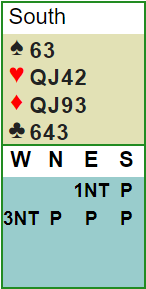

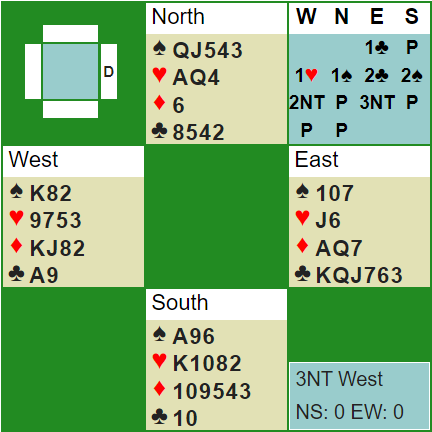
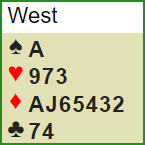


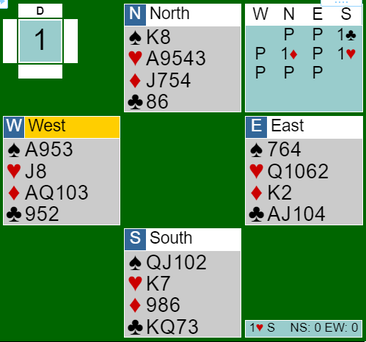
 RSS Feed
RSS Feed